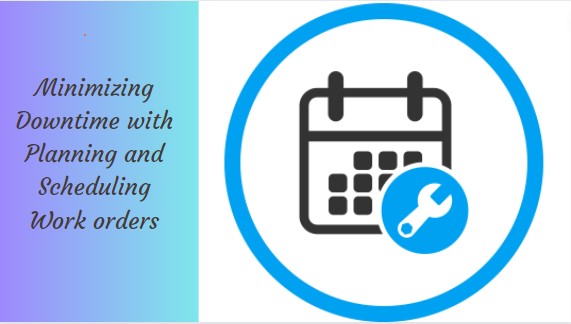
Planning and Scheduling Work Orders: Strategies from top performing maintenance teams
Madhurima Sanyal |
21 Jun 2024 |
10:22 AM
- Importance of planning and scheduling in Maintenance Operations
- Foundations of Maintenance Planning
- Essentials of Maintenance Scheduling
- Best Practices for Effective Scheduling process
- Integration of Maintenance Planning and Scheduling
- Challenges and Solutions in Maintenance Planning and Scheduling
- Strategies for Overcoming Scheduling Challenges
- Mastering Maintenance Planning and Scheduling Work Requests
- Conclusion

How to overcome CMMS implementation challenges
Madhurima Sanyal 07 Jun 2024 | 05:54 AMLearn the intricacies of CMMS implementation in this comprehensive guide. Learn to navigate challenges, devise effective strategies, and avoid common pitfalls for a successful CMMS integration. Get started today! ...
Maintenance planning and scheduling form the backbone of efficient operations for maintenance team within any organization. Let's understand these critical aspects, their significance and role in maintaining smooth and effective work orders.
Understanding Maintenance Planning and Scheduling
Work order coordination is at the heart of maintenance planning, meticulously aligning resources, tools, and personnel to execute scheduled tasks efficiently. This comprehensive process involves assessing maintenance needs, anticipating potential issues, and devising proactive strategies to address them effectively. Conversely, work order schedules focuses on organizing these planned tasks within designated timeframes to minimize disruptions to regular operations.
Maintenance planning serves as the proactive foundation for identifying and addressing maintenance requirements before they intensify, ensuring optimal care for critical assets and equipment. Simultaneously, scheduling empowers teams to strategically allocate resources, thereby reducing downtime, optimizing work order creation and bolstering overall productivity.
Importance of planning and scheduling in Maintenance Operations
By implementing robust planning strategies, maintenance teams can foresee potential breakdowns, effectively preventing costly downtime and repairs. Similarly, scheduling assign tasks, ensures that weekly schedule for work orders are performed strategically, without impeding daily operations.
Imagine a scenario where a crucial piece of machinery unexpectedly fails, halting production. Best maintenance technician could have foreseen the issue and scheduled timely maintenance, preventing the sudden breakdown. This non-reactive maintenance approach minimizes disruptions and maximizes the lifespan of equipment, ultimately saving resources and enhancing overall operational efficiency.
Maintenance planning and scheduling are the guiding forces behind best maintenance teams. When executed efficiently, these strategies not only enhance equipment reliability but also optimize work orders, leading to increased profitability and customer satisfaction.
Foundations of Maintenance Planning
Maintenance planning serves as the strategic framework essential for the seamless functioning of maintenance activities within any organization. Let's break down the core elements and principles that define maintenance planning and explore how these principles are implemented within top-performing maintenance teams.
Defining Maintenance Planning
Maintenance planning involves the systematic approach to outlining procedures, schedules, and resources necessary for maintaining equipment and critical assets. It's about preventing reactive maintenance approach and establishing a roadmap to effectively manage maintenance schedule. Essentially, it's the proactive foresight that prevents unexpected breakdowns by ensuring timely upkeep.
Maintenance Planning Principles
The principles underlying maintenance planning are centered on preventive measures and strategic scheduling. Proactive maintenance, predictive analysis, and optimizing resources are fundamental. Utilizing historical data, employing predictive algorithms, and aligning maintenance schedules with operational requirements are crucial principles guiding successful work order-centric maintenance planning.
Implementing Maintenance Planning Processes
Implementing effective maintenance planning processes involves a meticulous approach. It encompasses establishing a structured work order, defining roles and responsibilities, leveraging technology for streamlined operations, and integrating maintenance planning with broader organizational goals. It's about fostering a culture where maintenance isn’t reactive but proactive and anticipatory.
By embedding maintenance planning principles into day-to-day operations, good teams transform their approach from reactive to proactive, significantly reducing unexpected downtimes and optimizing work order creation.
Maintenance planning isn't solely about fixing issues but strategically preventing them from occurring in the first place. It's the bedrock upon which efficient maintenance operations thrive, saving costs and enhancing overall productivity.
Essentials of Maintenance Scheduling
Understanding Maintenance Scheduling
Maintenance scheduling revolves around the strategic allocation of resources, time, and non-reactive maintenance team to complete tasks. It's the art of orchestrating maintenance activities to optimize productivity while minimizing downtime. Effective scheduling ensures that preventive maintenance metrics are achieved without impeding regular operations.
Maintenance Scheduling Principles
The principles underlying maintenance scheduling are rooted in preventive maintenance, strategic resource allocation, and operational optimization. Predictive algorithms, historical data analysis, and the utilization of CMMMS play a vital role in creating well-structured equipment manuals. Prioritizing critical assets and leveraging downtime cost analysis are key principles guiding efficient scheduling strategies.
Best Practices for Effective Scheduling process
Best practices in maintenance scheduling are centered around work orders and encompasses the following activities:
-
Leveraging CMMS software for streamlined schedule tasks - Efficiently managing work orders through Computerized Maintenance Management Systems (CMMS) software facilitates organized task allocation, optimized work order creation and tracking.
-
Balancing preventive maintenance tasks - Striking a balance between preventive maintenance ensures proactive care while addressing immediate issues promptly.
-
Utilizing predictive maintenance techniques are among the core practices - Employing preventive maintenance techniques enables proactive equipment maintenance based on data-driven insights, anticipating potential issues before they escalate.
-
Implementing Skill-Based Scheduling: Aligning the right skill sets with tasks through skill-based scheduling ensures that the most qualified personnel handle specific work orders.
Additionally, conducting regular equipment assessments and aligning schedules with production demands contribute significantly to effective work order.
By adhering to these best practices, top-performing maintenance teams seamlessly integrate maintenance schedules into the operational fabric as per equipment manuals. This integration minimizes downtime, extends asset life, and optimizes work order and maintenance costs, ultimately enhancing overall operational efficiency.
Maintenance scheduling isn't just about assigning tasks; it's a strategic maneuver that ensures the right tasks are performed at the right time, contributing to enhanced productivity and streamlined operations.
Integration of Maintenance Planning and Scheduling
For top-performing maintenance teams, the synergy between maintenance planning and scheduling revolves around effective management of work orders. But how do these critical facets align with broader business objectives, the strategies involved in harmonizing their processes, and the tools instrumental in achieving effective integration of work order?
Aligning Maintenance Goals with Business Objectives
The alignment of maintenance goals with broader business objectives heavily involves work orders. Integrating maintenance planning and scheduling strategies that resonate with overarching business goals ensures that work orders are orchestrated to directly contribute to the company's profitability, reliability, and customer satisfaction.
Strategies for Harmonizing Planning and Scheduling Processes
Strategies involve creating a unified roadmap, fostering communication between planning and scheduling teams, and leveraging advanced scheduling techniques focused on optimizing work order execution. This synchronization of efforts ensures minimized downtime and maximized efficiency in handling work orders.
Tools and Techniques for Effective Integration
Effective integration relies on leveraging cutting-edge tools and techniques. Utilizing Computerized Maintenance Management System, Enterprise Asset Management (EAM) software, and predictive maintenance analytics fosters streamlined integration. These technologies enable seamless coordination, real-time data analysis, and informed decision-making, ensuring an optimized work order flow.
Integrating maintenance planning and scheduling isn’t just about aligning calendars; it's about unifying strategies to enhance productivity, reduce costs, and prolong asset life. When done effectively, this integration results in a cohesive operational framework that underlines the success of top-performing
Challenges and Solutions in Maintenance Planning and Scheduling
Maintenance work orders come with their set of hurdles, but top-performing maintenance teams know how to navigate and overcome these challenges effectively. Understanding these hurdles and devising strategies in place is vital for achieving seamless operations.
Maintenance planning encounters various stumbling blocks. From inadequate resource allocation to overlooking historical data, these pitfalls often lead to inefficient planning and hinder effective work order management.
When planning takes a wrong turn, it can disrupt work order flows and impact productivity. Addressing these issues promptly and with structured solutions helps realign the planning process and rectify any adverse effects on work order schedules.
Strategies for Overcoming Scheduling Challenges
Scheduling work orders can become intricate due to unforeseen circumstances or resource constraints. Implementing agile scheduling strategies, leveraging technology for real-time adjustments, and fostering collaboration among maintenance teams are proven methods to overcome these challenges.
Maintenance teams need proactive strategies to tackle these common hurdles in planning and scheduling work orders. By addressing these challenges head-on, teams can optimize their operations, streamline work order management, and maintain equipment more effectively.
Book your demo with Proptor
Proptor stands out as the ideal choice of leading businesses for planning and scheduling work order in asset management due to its comprehensive and user-friendly features. Its intuitive interface simplifies the complex process of managing work orders, allowing for efficient assignment and tracking of tasks across various assets.
The platform's robust capabilities, such as real-time monitoring, predictive maintenance insights, and customizable work order enable streamlined coordination and optimization of maintenance schedules. Proptor's integration with data analytics and reporting tools further enhances decision-making, facilitating proactive maintenance strategies and reducing downtime.
Its scalability and adaptability make it an indispensable tool for maximizing asset performance while minimizing operational disruptions, making it a standout choice in the realm of work order planning and scheduling within asset management.
Mastering Maintenance Planning and Scheduling Work Requests
Best Practices for Optimal Facility Shutdown Management
Mastering facility shutdowns demands meticulous detailing and work order execution. Top maintenance crews understand the significance of strategic planning, allocating resources, and employing precise scheduling methodologies.
By prioritizing critical tasks, establishing clear communication channels, and leveraging advanced tools like CMMS, they effectively mitigate downtime during shutdowns, significantly enhancing overall facility productivity.
Achieving Excellence in Maintenance Planning
Maintenance planning is the cornerstone of successful work order execution. Best maintenance teams meticulously craft detailed plans, prepare Gantt charts incorporating preventive measures, predictive analysis, and leveraging historical data. By establishing comprehensive strategies, they ensure that assets receive timely attention, effectively preventing unexpected breakdowns and extending equipment lifespan.
Steps for Enhancing Skills in Maintenance Scheduling
Daily schedule involves skillful orchestration of tasks within specific timelines. Leading teams focus on continuous skill development, aligning schedules with production demands, and refining scheduling practices. Leveraging software tools for real-time monitoring and adjustments, these teams optimize resource allocation and reduce downtime, thereby boosting operational efficiency.
Mastering the intricacies of maintenance planning and scheduling work requests is an ongoing journey. By adopting these strategic approaches, maintenance teams can not only address challenges effectively but also unlock opportunities for enhanced productivity and long-term cost savings.
Conclusion
It can be safely concluded that mastering maintenance planning and scheduling work order stands as a cornerstone for top-performing maintenance teams. By implementing strategic approaches, leveraging advanced tools like CMMS, and focusing on preventive measures, these teams excel in optimizing resources and mitigating downtime during facility shutdowns.
The meticulous work order management ensures seamless execution, enhancing overall facility productivity and prolonging equipment lifespan. Continuous skill enhancement in maintenance scheduling further enables these teams to align with production demands effectively. Embracing these best practices not only streamlines operations but also sets the stage for sustained efficiency and cost-effectiveness in maintenance endeavors.